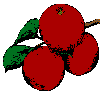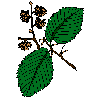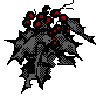The Wiccan Rede Project resurrection home ...
gocek.org pagan content ...
gocek.org home ...
Contact
The Tarahill Tree Lore resurrection at gocek.org
Sacred Woods and the Lore of Trees
Originally published at tarahill.com/treelore/trees.html, rescued from archive.org
alder (Alnus spp.):
This tree is a water lover. The oily water resistant wood has been used
extensively for underwater foundations and pilings in Venice and elsewhere. It
is used in dairy vessels and the branches in making whistles. It is associated
with Bran, as He used His body as a bridge to span dangerous waters. It is used
in the construction of bridges. Bran's Head was oracular. Alder indicates
protection and oracular powers.
apple (Malus spp.):


A dense, fine-grained, rosy-coloured wood with a slightly sweet smell. The
Apple is the earliest cultivated tree. It is associated with choice. At
Somerset, an auction was held for single acre plots on two pieces of common
land. Plots were marked and matching marks made on the fruit. The apples were
then placed in a bag and commoners were allocated land by the distribution of
the fruit. All the acres of land were similar, as many times today choices must
be made between similar and equally attractive things. Regardless, the choice
must be made. In Norse myth, Idunna was the keeper of the 'apples of
immortality' which kept the Gods young. The 'fruit-bearing tree' refered to by
Tacitus in his description of Norse runic divination may have been the apple.
Apple indicates choice, and is useful for love and healing magic.
ash (Fraxinus spp.):


A strong, straight-grained wood; sometimes has 'olive' streaks or stripes in
the grain. The European variety (fraxinus excelcior) was referred to in the
Eddas as the species of Yggdrasil - the 'World-Tree". The first man, named Ask,
was created from an ash log. Ash was commonly used to make spears because of
its 'springiness' and straight grain. In North America, strips of black ash
were split along the grain to make splints for baskets and hoops. It is used in
weaver's beams. Women would weave cloth and intermingling threads together in a
tight pattern as the microcosm and the macrocosm are united. Ash can be used in
spells requiring focus and strength of purpose, and indicates the linking of the
inner and outer worlds.
beech (Fagus spp.):
Beech wood is closely grained, very easy to work giving a smooth even
surface. At one time Beech tablets were used as writing surfaces because of the
above mentioned qualities. Beech and book have the same word origins. Beech is
concerned with ancient knowledge as revealed in old objects, places and
writings. Beech indicates guidance from the past to gain insight which protects
and provides a solid base upon which all relies.
birch (Betula spp.):


A lovely pale, fine-grained wood. Long associated with fertility and
healing magic, birch twigs were used to bestow fertility on cattle and
newlyweds, and children's cradles were made from its wood. Birch is one of the
first trees to grow on bare soil and thus it births the entire forest.
Criminals were at one time birched to drive out evil influences on them, to
renew them for the new year. Birch was associated with Thor, probably in
recognition of his role as an agricultural and fertility deity. Birch is an
incredibly useful tree - nearly every part of it is edible, and it's sap was an
important source of sugar to Native Americans and early settlers. The inner
bark provides a pain reliever and the leaves are used to treat arthritis. It's
bark was used for everything from paper to canoe hulls, and axe handles were
also made from Birch. Birch is most useful for fertility and healing spells.
blackthorn (Prunus spinosa):
Blackthorn is a winter tree. The sloe, its fruits ripen and sweeten only
after the nip of the frost. White flowers are seen even before the leaves in
the spring. It is black barked with vicious thorns and grows in dense thickets.
The wood is used in the cudgel shillelagh and Blasting Stick. Its thorns are
used to pierce waxen images. Blackthorn indicates strong action of fate or
outside influences that must be obeyed.
elder (Sambucus spp.):
The Latin name sambucus is derived from a Greek word for a wind
instrument made from elder. The pith can easily be removed from the small
branches to make a flute. Elder regrows damaged branches with ease and can root
rapidly from any part. A tea for purifying the blood can be made from the
flowers and wine from the fruit, but in general the tree is poisonous. In Norse
mythology, the Goddess Freya chose the black elder as her home. In medieval
times it was the abode of witches and it was considered dangerous to sleep under
its branches or to cut it down. Sticks of Elder were used as magical horses by
Witches. Elder indicates the end in the beginning and the beginning in the end.
Life in Death and Death in Life.
elm (Ulmus spp.):


A slightly fibrous, tan-coloured wood with a slight sheen. Elm is often
associated with Mother and Earth Goddesses, and was said to be the abode of
faeries, explaining Kipling's injunction; "Ailim be the lady's tree; burn it not
or cursed ye'll be". Elm wood is valued for it's resistance to splitting, and
the inner bark was used for cordage and chair caning. Elm adds stability and
grounding to a spell.
fir (Abies spp.):
Fir is a very tall slender tree that grows in mountainous regions on the
upper slopes. Fir cones respond to rain by closing and the sun by opening. Fir
can see over great distance to the far horizon beyond and below. Fir indicates
high views and long sights with clear vision of what is beyond and yet to come.
hawthorn (Crataegus oxyacantha):
A light, hard, apple-like wood. Hawthorn usually doesn't grow much bigger
than a shrub, and is popular in England as a hedge plant. The wood from the
Hawthorn provides the hottest fire known. Its leaves and blossoms are used to
create a tea to aid with anxiety, appetite loss and poor circulation. The
Greeks and Romans saw the hawthorn as symbolic of hope and marriage, but in
medieval Europe it was associated with witchcraft and considered to be unlucky.
This seeming contradiction is to be expected from a tree with such beautiful
blossoms and such deadly-looking thorns. Hawthorn can be used for protection,
love and marriage spells.
hazel (Corylus avallania):
Hazel is another food tree. In Celtic tradition, the Salmon of Knowledge is
said to eat the 9 nuts of poetic wisdom dropped into its sacred pool from the
hazel tree growing beside it. Each nut eaten by the salmon becomes a spot on
its skin. The Hazel tree provided shade, protection and baskets. In Europe and
North America, hazel is commonly used for 'water-witching' - the art of finding
water with a forked stick. Magically, hazel wood is used to gain knowledge,
wisdom and poetic inspiration.
holly (Ilex aquifolium):


A beautiful white wood with an almost invisible grain; looks very much like
ivory. Holly is associated with the death and rebirth symbolism of winter in
both Pagan and Christian lore. In Arthurian legend, Gawain (representing the
Oak King of summer) fought the Green Knight, who was armed with a holly club to
represent winter. It is one of the three timbers used in the construction of
chariot wheel shafts. It was used in spear shafts also. The qualities of a
spear shaft are balance and directness, as the spear must be hefted to be thrown
the holly indicates directed balance and vigour to fight if the cause is just.
Holly may be used in spells having to do with sleep or rest, and to ease the
passage of death.
larch (Larix europaea):

A light softwood, very similar to spruce. Larch is one of the few conifers
which sheds its needles in the winter. It is closely related to the North
American tamarack (larix laricina). The larch plays an important role in Sami
(Lapp) and Siberian mythology where it takes the place of the ash as the
World-tree. Their shamans use larch wood to rim their ceremonial drums. The
smoke from burning larch is said to ward off evil spirits. Larch may be used
for protection and to induce visions.
maple (Acer spp.):
A very hard, pale, fine-grained wood. Although the sugar maple has the
highest sugar content in its sap, all maple species can be tapped to make syrup
and sugar, making them a vital resource to early North American settlers. In
north-eastern North America, the annual 'sugaring-off' usually coincides with
the vernal equinox, making it one of the first signs of spring. Maple can bring
success and abundance.
oak (Quercus spp.):

Oak has been considered sacred by just about every culture that has
encountered the tree, but it was held in particular esteem by the Norse and
Celts because of its size, longevity, and nutritious acorns. The oak is
frequently associated with Gods of thunder and lightening such as Zeus, Thor,
and the Lithuanian God Perkunas. This association may be due to the oak's habit
of being hit by lightening during storms. Specific oak trees have also been
associated with the 'Wild Hunt', which is led by Herne in England and by Wodin
in Germany. In general, oak can be used in spells for protection, strength,
success and stability; the different varieties will lend their own special
'flavour' to the magic.

Red Oak (Quercus rubra)
A strong, straight-grained, slightly porous wood with a slight reddish hue.
Its energy is a bit lighter and more 'firey' than the other oaks.

White Oak (Quercus alba)
Darker and denser than red oak. It's strength and density have led to its
being used in barrel-making and shipbuilding. Useful for spells requiring
strength and solidity.

Brown (English) Oak (Quercus robur)
A richly-coloured dark brown wood. Brown oak has a very earthy feel, and is
useful for grounding. 'Bog oak' is brown oak which has fallen into a peat bog and
been preserved there for hundreds of years until it begins to have the consistancy of coal.
pear (Pyrrus spp.):

The Roman author Tacitus described how the Germanii would carve runes into
the wood of a fruit tree. This is often assumed to be the apple tree, but may
well have been the pear which is considered by some to be of the same genus as
the apple. In the 5th century, Constantius told of a pear tree which was
honored by the Northmen. The pear tree is also mentioned in literature and
folklore connected with love and temptation.
pine (Pinus spp.):
The Pine tree is an evergreen, its old title was "the sweetest of woods".
Its needles are a valuable source of vitamin C and can loosen a tight chest.
The scent of Pine is useful in the alleviation of guilt. The Bach's flower
remedies lists it for dealing with feelings of guilt. Pine indicates issues of
guilt within you.
poplar (Populus spp.):
The White Poplar flourishes beside rivers, in marshes and in other watery
areas. The pith is star shaped. The upper leaves are green, the underside is
silver. The wood was used in the making of shields. Leaves move with every
puff of wind. It is commonly referred to as the talking, whispering and
quivering tree. The Anglo-Saxon rune poem seems to refer to the poplar as being
associated with the rune berkano. Heracles wore a crown of poplar leaves when
he retrieved Cerberus from Hades, and the upper surface of the leaves was thus
darkened from Hades' smokey fumes. In Christian lore, the quaking poplar
(aspen) was used to construct Christ's cross, and the leaves of the tree quiver
when they remember this fact. The Poplar's ability to resist and to shield, its
association with speech, language and the Winds indicates an ability to endure
and conquer.
rowan (Sorbus aucuparia):
The Rowan tree (also called Mountain Ash) is long known for aid and
protection against enchantment. Sticks of the Rowan were used to carve Runes
on. It was also used in the art of metal divining. Rowan spays and crosses
were placed over cattle in pens and over homes for protection. Its lovely red
berries feed the birds in winter. The berries have a tiny pentagram on them.
The pentagram is the ancient symbol of protection. The Rowan tree indicates
protection and control of the senses from enchantment and beguiling.
willow (Salix babylonica):
The willow is another water loving tree. Willow bark contains Salicin which
is used in the treatment of rheumatic fever and various damp diseases. Her
catkins, which appear in early spring before her leaves, attract bees to start
the cycle of pollination. In western tradition it is a symbol of mourning and
unlucky love. The Latin name for the weeping willow refers to the psalm in
which the Hebrews mourn their captivity in Babylon by the willows. Willow
indicates cycles, rhythms and the ebb and flux.
yew (Taxus baccata):


A beautifully smooth, gold-coloured wood with a wavy grain. All parts of
the tree are poisonous except the fleshy covering of the berry, and its
medicinal uses include a recently discovered treatment for cancer. Long
associated with magic, death, rebirth and the runes, the yew may be the
oldest-lived tree in the world. Ancient yews can be found in churchyards all
over Britain, where they often pre-date even the oldest churches. There are
some convincing arguements for it being the original 'World-tree' of
Scandinavian mythology. In Europe, yew wood was used for making bows, while on
the northwest coast of North America, the Pacific yew (Taxus brevifolia) is used
by the Haida and other tribes for making masks and boxes
(Tara Hill runes are now made with Pacific yew).
Yew may be used to enhance magical and psychic abilities, and to induce visions.
Jennifer Smith, runesmith -at- tarahill -dot- com

















